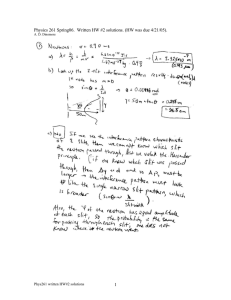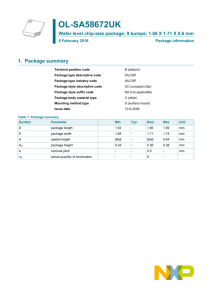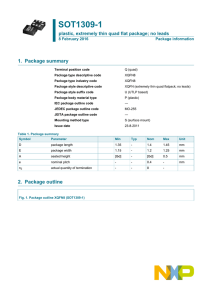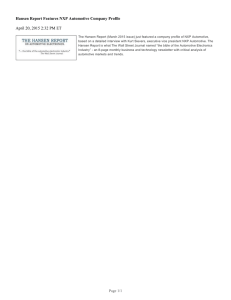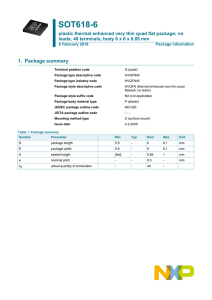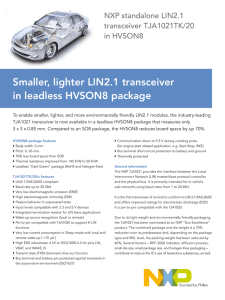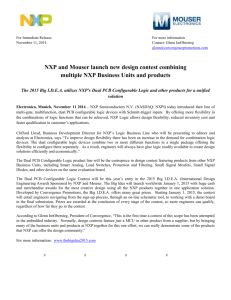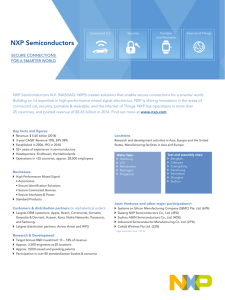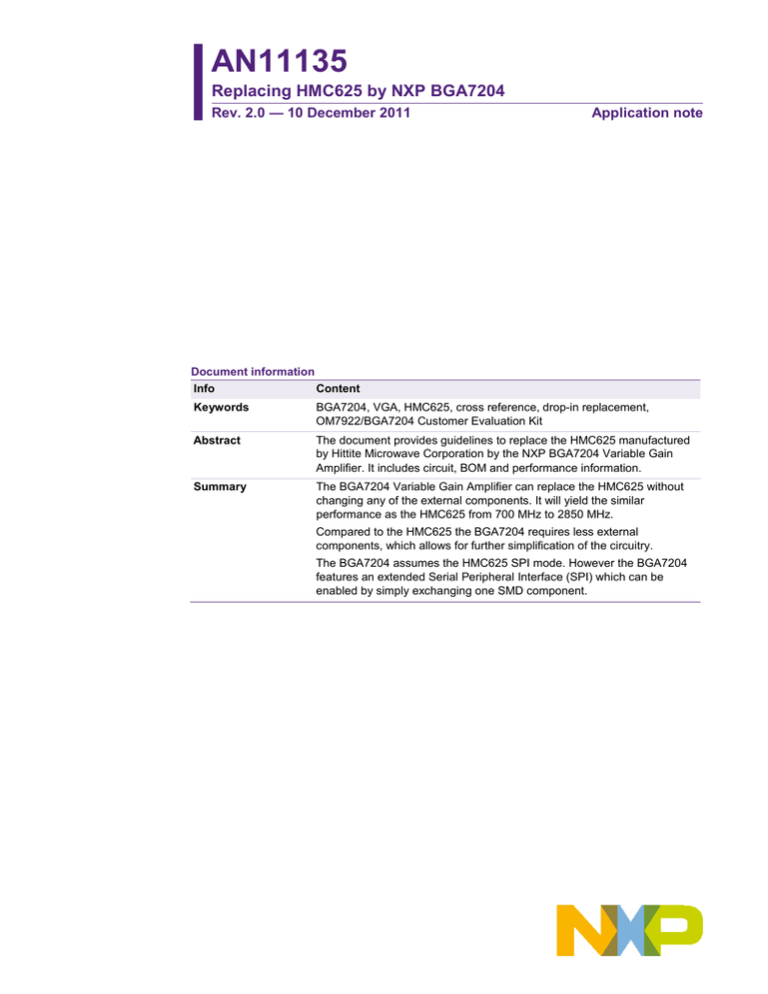
AN11135
Replacing HMC625 by NXP BGA7204
Rev. 2.0 — 10 December 2011
Application note
Document information
Info
Content
Keywords
BGA7204, VGA, HMC625, cross reference, drop-in replacement,
OM7922/BGA7204 Customer Evaluation Kit
Abstract
The document provides guidelines to replace the HMC625 manufactured
by Hittite Microwave Corporation by the NXP BGA7204 Variable Gain
Amplifier. It includes circuit, BOM and performance information.
Summary
The BGA7204 Variable Gain Amplifier can replace the HMC625 without
changing any of the external components. It will yield the similar
performance as the HMC625 from 700 MHz to 2850 MHz.
Compared to the HMC625 the BGA7204 requires less external
components, which allows for further simplification of the circuitry.
The BGA7204 assumes the HMC625 SPI mode. However the BGA7204
features an extended Serial Peripheral Interface (SPI) which can be
enabled by simply exchanging one SMD component.
AN11135
NXP Semiconductors
BGA7204
Revision history
Rev
Date
Description
2.0
20111210
Reviewed document
1.0
20111129
Initial document
Contact information
For more information, please visit: http://www.nxp.com
For sales office addresses, please send an email to: salesaddresses@nxp.com
AN11135
Application note
All information provided in this document is subject to legal disclaimers.
Rev. 2.0 — 10 December 2011
© NXP B.V. 2011. All rights reserved.
2 of 16
AN11135
NXP Semiconductors
BGA7204
1. Introduction
This document describes how to replace the VGA HMC625 manufactured by Hittite
Microwave Corporation by the NXP BGA7204.
The BGA7204 MMIC is an extremely linear Variable Gain Amplifier (VGA), operating
from 0.4 GHz to 2.75 GHz. At minimum attenuation it has a gain of 18.5 dB, an output
IP3 of 38 dBm and a noise figure of 7 dB. The attenuation range is 31.5 dB with an
attenuation step of 0.5 dB.
The BGA7204 has also been designed to functionally replace the HMC625. It features
the same footprint. The pin definition is compatible with the HMC625: when placed in the
HMC625 application circuit, the BGA7204 will power-up with a compatible SPI (basic)
interface. However the extra features (like chip temperature read out) will not be
available in this mode.
2. Application Circuit for drop-in replacement
2.1 OM7922/BGA7204 Customer Evaluation Kit
In this application note the printed circuit board of the BGA7204
Customer Evaluation Kit (OM7922/BGA7204) has been used as
base. It is possible to populate this printed circuit board such that
it implements the HMC625 reference application circuit.
The OM7922/BGA7204 Customer Evaluation Kit can be ordered.
Please contact your local NXP sales representative for further information.
Fig 1.
AN11135
Application note
Top layer printed circuit board of the BGA7204 Customer Evaluation Kit
(OM7922/BGA7204).
All information provided in this document is subject to legal disclaimers.
Rev. 2.0 — 10 December 2011
© NXP B.V. 2011. All rights reserved.
3 of 16
AN11135
NXP Semiconductors
BGA7204
2.2 Schematic
In the picture below the BGA7204 is placed in the HMC625 reference application circuit,
without changing any of the external components. Not all components are needed, but
this drop-in approach could simplify the component qualification at the customer side, at
the expense of placing unnecessary components.
Fig 2.
The HMC625 application circuit using NXP’s BGA7204.
2.3 Component list
In the Table below the used components have been listed. It also contains different bill of
materials, which can be used to optimize for cost or performance, see Chapter 3.
Table 1.
Components values for drop-in replacement (column: HMC625), for low cost
replacement (column: Low cost) and for obtaining BGA7204 performance as
published in the BGA7204 data sheet (column: BGA7204 data sheet
performance).
Component
AN11135
Application note
HMC625
Low cost
BGA7204 data sheet
performance
C1
100 pF
n.c.
n.c.
C2
100 pF
n.c.
C3 – C5
100 pF
n.c.
n.c.
C6
100 pF
100 pF
100 pF
All information provided in this document is subject to legal disclaimers.
Rev. 2.0 — 10 December 2011
n.c. or 0 Ω jumper
[1]
© NXP B.V. 2011. All rights reserved.
4 of 16
AN11135
NXP Semiconductors
BGA7204
Component
HMC625
Low cost
BGA7204 data sheet
performance
C7
100 pF
100 pF
100 pF
C8
100 pF
100 pF
100 pF
C9
100 pF
100 pF
1 nF
C11
1 nF
1 nF
47 nF
C12
1 nF
1 nF
100 pF
C14
2.2 µF
2.2 µF
4.7 µF
[3]
24 nH
24 nH
47 nH
R15
1.8 Ω
1.8 Ω or 0 Ω
0Ω
L1
[1]
Place 0 Ω jumper to use the BGA7204’s extended SPI mode.
[2]
1 nF decoupling capacitor C9 value will remove 300 MHz dip, see Chapter 3.
[3]
Important: only use wire wound RF-choke like the Murata inductor LQW18-series.
[2]
2.4 Measurements
This paragraph plots the performance obtained using the HMC625 component values on
the printed circuit board used in OM7922/BGA7204 Customer Evaluation Kit. This has
been compared with the performance obtained using the NXP BGA7204 application
circuit as being published in the Data Sheet.
2.4.1 S-parameters
The S-parameters depend on the used quality of the printed circuit board (etching spread
and the length of the RF – tracks). Using the HMC625 BOM a resonance around 300
MHz occurs in the S-parameters. Chapter 3 describes how this can be solved.
2.4.1.1
Gain
The gain between 700 MHz and 2850 MHz is identical for both the HMC625
configuration as well as the OM7922/BGA7204 configuration.
The gain below 700 MHz drops up to 0.7 dB which is caused by the different RF-choke
(24 nH instead of 47 nH).
AN11135
Application note
All information provided in this document is subject to legal disclaimers.
Rev. 2.0 — 10 December 2011
© NXP B.V. 2011. All rights reserved.
5 of 16
AN11135
NXP Semiconductors
BGA7204
S21 (in dB)
S21 vs Frequency (Gmax = DSA 63)
20
18
16
14
12
10
8
6
4
2
S21 BGA7204 BOM
S21 HMC625 BOM
0
1
2
3
4
3
4
3
4
Frequency (in GHz)
S21 vs Frequency (Gmid = DSA 32)
4
2
S21 (in dB)
0
-2
-4
S21 BGA7204 BOM
-6
S21 HMC625 BOM
-8
-10
-12
0
1
2
Frequency (in GHz)
S21 vs Frequency (Gmin = DSA 0)
-10
-12
S21 (in dB)
-14
-16
-18
S21 BGA7204 BOM
-20
S21 HMC625 BOM
-22
-24
-26
0
1
2
Frequency (in GHz)
Fig 3.
AN11135
Application note
Gain at max, mid and min attenuation.
All information provided in this document is subject to legal disclaimers.
Rev. 2.0 — 10 December 2011
© NXP B.V. 2011. All rights reserved.
6 of 16
AN11135
NXP Semiconductors
BGA7204
2.4.1.2
Input return loss
The component value of the RF choke (L1 = 24 nH instead of 47 nH) also has minor
influence on the input return loss.
S11 vs Frequency (Gmax = DSA 63)
0
S11 BGA7204 BOM
S11 (in dB)
-5
S11 HMC625 BOM
-10
-15
-20
0
1
2
Frequency (in GHz)
3
4
3
4
3
4
S11 vs Frequency (Gmid = DSA 32)
0
S11 BGA7204 BOM
-10
S11 (in dB)
S11 HMC625 BOM
-20
-30
-40
-50
0
1
2
Frequency (in GHz)
S11 vs Frequency (Gmin = DSA 0)
0
S11 BGA7204 BOM
-10
S11 (in dB)
S11 HMC625 BOM
-20
-30
-40
-50
0
Fig 4.
AN11135
Application note
1
2
Frequency (in GHz)
Input return loss at max, mid and min attenuation
All information provided in this document is subject to legal disclaimers.
Rev. 2.0 — 10 December 2011
© NXP B.V. 2011. All rights reserved.
7 of 16
AN11135
NXP Semiconductors
BGA7204
2.4.1.3
Output return loss
The component value of the RF choke (L1 = 24 nH) has influence on the output return
loss. For frequencies below 700 MHz it might make sense to improve this by changing
the component value of the RF choke (L1 = 47 nH instead of 24 nH), see Chapter 3.
S22 vs Frequency (Gmax = DSA 63)
0
S22 BGA7204 BOM
S22 HMC625 BOM
S22 (in dB)
-5
-10
-15
-20
0
1
2
Frequency (in GHz)
3
4
S22 vs Frequency (Gmid = DSA 32)
0
S22 BGA7204 BOM
S22 (in dB)
-5
S22 HMC625 BOM
-10
-15
-20
0
1
3
4
S22 vs Frequency (Gmin = DSA 0)
0
S22 BGA7204 BOM
-5
S22 (in dB)
2
Frequency (in GHz)
S22 HMC625 BOM
-10
-15
-20
0
Fig 5.
AN11135
Application note
1
2
Frequency (in GHz)
3
4
Output return loss at max, mid and min attenuation
All information provided in this document is subject to legal disclaimers.
Rev. 2.0 — 10 December 2011
© NXP B.V. 2011. All rights reserved.
8 of 16
AN11135
NXP Semiconductors
BGA7204
2.4.2 Output third order intercept point
No degradation on OIP3 for frequencies above 700 MHz by using the HMC625 bill of
material.
The OIP3 at 400 MHz drops 0.7 dB, resulting from the gain drop at frequencies below
700 Mhz. The component value of the RF choke (L1 = 24 nH) causes the gain drop. This
can be improved, see Chapter 3.
OIP3 versus Frequency (Gmax = DSA 63, Pin=12dBm/tone, F∆=1MHz)
45
43
OIP3 (in dBm)
41
39
37
35
33
OIP3 HMC625 BOM
31
OIP3 BGA7204 BOM
29
27
0
0.5
1
1.5
2
2.5
3
Frequency (in GHz)
Fig 6.
OIP3, BGA7204 using the BGA7204 BOM and the HMC625 BOM
2.4.3 Output power at 1 dB gain compression
No significant change in OP1dB performance has been measured.
AN11135
Application note
All information provided in this document is subject to legal disclaimers.
Rev. 2.0 — 10 December 2011
© NXP B.V. 2011. All rights reserved.
9 of 16
AN11135
NXP Semiconductors
BGA7204
Pout at 1dB Compression vs Frequency (Gmax = DSA 63)
30
28
P1dB (in dBm)
26
24
22
20
18
P1dB HMC625 BOM
16
P1dB BGA7204 BOM
14
12
10
0
0.5
1
1.5
2
2.5
3
Frequency (in GHz)
Fig 7.
P1dB out, BGA7204 using BGA7204 BOM and the HMC625 BOM
3. Tips and tricks
The application circuitry described in Chapter 2 leaves the bill of material of the HMC625
reference application circuitry intact. This means that unnecessary external components
are being placed. Also this limits features and performance of the BGA7204. This chapter
describes how to optimize the performance and features using the HMC625 reference
board.
3.1 Saving on external components
Not all components needed for the HMC625 are required for the BGA7204. In the table
of paragraph 2.3 the ‘low cost’ column shows which components can be omitted.
3.2 Restoring low frequency performance
The NXP VGA BGA7204 can handle frequencies down to 400MHz. The RF choke (L1)
must be changed from 24 nH to 47 nH to extend the frequency range down to 400 MHz.
See the table of paragraph 2.3 component list column ‘BGA7204 Data Sheet performance.’
AN11135
Application note
All information provided in this document is subject to legal disclaimers.
Rev. 2.0 — 10 December 2011
© NXP B.V. 2011. All rights reserved.
10 of 16
AN11135
NXP Semiconductors
BGA7204
3.3 Using extended SPI mode
The BGA7204 can be set to extended SPI mode which allows extra features (like chip
temperature read out), to use this mode some changes on the BOM has to be done. The
position on the printed circuit board for the capacitor C2 needs to be used to ground pin
7, by placing a 0 Ω jumper. See also the table of paragraph 2.3 component list column
‘BGA7204 Data Sheet performance.’
When pin 7 is not grounded it will pull-up to logic high, yielding the HMC625 compatible
mode (basic mode). Please refer to the Data Sheet for the features of the extended
mode. Also mind the fact that in extended mode daisy chaining of multiple devices is not
possible.
3.4 Removing the 300 MHz dip
The S-parameter graphs reveal a dip around 300 MHz (gain, output return loss). This is
caused by the position of the RF de-coupling capacitors (C9, C12 and C14) relative to
the RF choke (L1). The exact frequency and magnitude of the dip is therefore depending
on the layout of the components on the printed circuit. The dip is also visible when using
the HMC625.
The dip can be avoided by placing the RF-decoupling capacitors (C9, C12 and C14)
close to the RF choke (L1), although this is not always possible due to keep out areas for
component placement machine.
Another option is to change the position of the RF-decoupling capacitors, putting the 1 nF
capacitor nearby the RF choke (L1) by swapping the component values of C9 and C12.
C9 becomes 1 nF and C12 becomes 100 pF, see also the table of paragraph 2.3
component list column ‘BGA7204 Data Sheet performance.’
The graph below depicts the effect on swapping both capacitors (C9 versus C12) on the
OM7922/BGA7204 printed circuit board. On this board the distance between those
capacitors are much larger than on the HMC625 board making the dip more
1
pronounced . The blue graph shows the performance using the HMC625 component
values; the red graph shows the performance after swapping C9 and C12.
1
The RF-decoupling capacitors are placed far from the RF choke to allow for the placement of a test
socket.
AN11135
Application note
All information provided in this document is subject to legal disclaimers.
Rev. 2.0 — 10 December 2011
© NXP B.V. 2011. All rights reserved.
11 of 16
AN11135
NXP Semiconductors
BGA7204
Removing 300 MHz dip (Gmax = DSA = 63)
25
20
15
S21 SWAP Capacitor
S21 & S22 (in dB)
10
5
S21 HMC625 BOM
0
S22 SWAP Capacitor
S22 HMC625 BOM
-5
-10
-15
-20
-25
0
200
400
600
800
1000
Frequency (in GHz)
Fig 8.
AN11135
Application note
Gain and output return loss at minimum attenuation of the BGA7204 using the
printed circuit board of the OM7922/BGA7204 Customer Evaluation Kit. The
effect of swapping C9 and C12 is shown, see text.
All information provided in this document is subject to legal disclaimers.
Rev. 2.0 — 10 December 2011
© NXP B.V. 2011. All rights reserved.
12 of 16
AN11135
NXP Semiconductors
BGA7204
4. Legal
information
4.1 Definitions
Draft — The document is a draft version only. The content is still under
internal review and subject to formal approval, which may result in
modifications or additions. NXP Semiconductors does not give any
representations or warranties as to the accuracy or completeness of
information included herein and shall have no liability for the consequences
of use of such information.
4.2 Disclaimers
Limited warranty and liability — Information in this document is believed to
be accurate and reliable. However, NXP Semiconductors does not give any
representations or warranties, expressed or implied, as to the accuracy or
completeness of such information and shall have no liability for the
consequences of use of such information.
In no event shall NXP Semiconductors be liable for any indirect, incidental,
punitive, special or consequential damages (including - without limitation lost profits, lost savings, business interruption, costs related to the removal
or replacement of any products or rework charges) whether or not such
damages are based on tort (including negligence), warranty, breach of
contract or any other legal theory.
Notwithstanding any damages that customer might incur for any reason
whatsoever, NXP Semiconductors’ aggregate and cumulative liability
towards customer for the products described herein shall be limited in
accordance with the Terms and conditions of commercial sale of NXP
Semiconductors.
Right to make changes — NXP Semiconductors reserves the right to make
changes to information published in this document, including without
limitation specifications and product descriptions, at any time and without
notice. This document supersedes and replaces all information supplied prior
to the publication hereof.
Suitability for use — NXP Semiconductors products are not designed,
authorized or warranted to be suitable for use in life support, life-critical or
safety-critical systems or equipment, nor in applications where failure or
malfunction of an NXP Semiconductors product can reasonably be expected
to result in personal injury, death or severe property or environmental
damage. NXP Semiconductors accepts no liability for inclusion and/or use of
NXP Semiconductors products in such equipment or applications and
therefore such inclusion and/or use is at the customer’s own risk.
Applications — Applications that are described herein for any of these
products are for illustrative purposes only. NXP Semiconductors makes no
representation or warranty that such applications will be suitable for the
specified use without further testing or modification.
Customers are responsible for the design and operation of their applications
and products using NXP Semiconductors products, and NXP
Semiconductors accepts no liability for any assistance with applications or
AN11135
Application note
customer product design. It is customer’s sole responsibility to determine
whether the NXP Semiconductors product is suitable and fit for the
customer’s applications and products planned, as well as for the planned
application and use of customer’s third party customer(s). Customers should
provide appropriate design and operating safeguards to minimize the risks
associated with their applications and products.
NXP Semiconductors does not accept any liability related to any default,
damage, costs or problem which is based on any weakness or default in the
customer’s applications or products, or the application or use by customer’s
third party customer(s). Customer is responsible for doing all necessary
testing for the customer’s applications and products using NXP
Semiconductors products in order to avoid a default of the applications and
the products or of the application or use by customer’s third party
customer(s). NXP does not accept any liability in this respect.
Export control — This document as well as the item(s) described herein
may be subject to export control regulations. Export might require a prior
authorization from competent authorities.
Evaluation products — This product is provided on an “as is” and “with all
faults” basis for evaluation purposes only. NXP Semiconductors, its affiliates
and their suppliers expressly disclaim all warranties, whether express,
implied or statutory, including but not limited to the implied warranties of noninfringement, merchantability and fitness for a particular purpose. The entire
risk as to the quality, or arising out of the use or performance, of this product
remains with customer.
In no event shall NXP Semiconductors, its affiliates or their suppliers be
liable to customer for any special, indirect, consequential, punitive or
incidental damages (including without limitation damages for loss of
business, business interruption, loss of use, loss of data or information, and
the like) arising out the use of or inability to use the product, whether or not
based on tort (including negligence), strict liability, breach of contract, breach
of warranty or any other theory, even if advised of the possibility of such
damages.
Notwithstanding any damages that customer might incur for any reason
whatsoever (including without limitation, all damages referenced above and
all direct or general damages), the entire liability of NXP Semiconductors, its
affiliates and their suppliers and customer’s exclusive remedy for all of the
foregoing shall be limited to actual damages incurred by customer based on
reasonable reliance up to the greater of the amount actually paid by
customer for the product or five dollars (US$5.00). The foregoing limitations,
exclusions and disclaimers shall apply to the maximum extent permitted by
applicable law, even if any remedy fails of its essential purpose.
4.3 Trademarks
Notice: All referenced brands, product names, service names and
trademarks are property of their respective owners.
All information provided in this document is subject to legal disclaimers.
Rev. 2.0 — 10 December 2011
© NXP B.V. 2011. All rights reserved.
13 of 16
AN11135
NXP Semiconductors
BGA7204
5. List of figures
Fig 1.
Fig 2.
Fig 3.
Fig 4.
Fig 5.
Fig 6.
Fig 7.
Fig 8.
Top layer printed circuit board of the BGA7204
Customer Evaluation Kit (OM7922/BGA7204). . 3
The HMC625 application circuit using NXP’s
BGA7204. ......................................................... 4
Gain at max, mid and min attenuation. ............. 6
Input return loss at max, mid and min
attenuation ........................................................ 7
Output return loss at max, mid and min
attenuation ........................................................ 8
OIP3, BGA7204 using the BGA7204 BOM and
the HMC625 BOM............................................. 9
P1dB out, BGA7204 using BGA7204 BOM and
the HMC625 BOM........................................... 10
Gain and output return loss at minimum
attenuation of the BGA7204 using the printed
circuit board of the OM7922/BGA7204
Customer Evaluation Kit. The effect of swapping
C9 and C12 is shown, see text. ...................... 12
AN11135
Application note
All information provided in this document is subject to legal disclaimers.
Rev. 2.0 — 10 December 2011
© NXP B.V. 2011. All rights reserved.
14 of 16
AN11135
NXP Semiconductors
BGA7204
6. List of tables
Table 1.
Components values for drop-in replacement
(column: HMC625), for low cost replacement
(column: Low cost) and for obtaining BGA7204
performance as published in the BGA7204 data
sheet
(column:
BGA7204
data
sheet
performance)..................................................... 4
AN11135
Application note
All information provided in this document is subject to legal disclaimers.
Rev. 2.0 — 10 December 2011
© NXP B.V. 2011. All rights reserved.
15 of 16
AN11135
NXP Semiconductors
BGA7204
7. Contents
1.
2.
2.1
2.2
2.3
2.4
2.4.1
2.4.1.1
2.4.1.2
2.4.1.3
2.4.2
2.4.3
3.
3.1
3.2
3.3
3.4
4.
4.1
4.2
4.3
5.
6.
7.
Introduction ......................................................... 3
Application Circuit for drop-in replacement ..... 3
OM7922/BGA7204 Customer Evaluation Kit ..... 3
Schematic .......................................................... 4
Component list ................................................... 4
Measurements ................................................... 5
S-parameters ..................................................... 5
Gain ................................................................... 5
Input return loss ................................................. 7
Output return loss............................................... 8
Output third order intercept point........................ 9
Output power at 1 dB gain compression ............ 9
Tips and tricks ................................................... 10
Saving on external components ....................... 10
Restoring low frequency performance .............. 10
Using extended SPI mode................................ 11
Removing the 300 MHz dip .............................. 11
Legal information .............................................. 13
Definitions ........................................................ 13
Disclaimers....................................................... 13
Trademarks ...................................................... 13
List of figures..................................................... 14
List of tables ...................................................... 15
Contents ............................................................. 16
Please be aware that important notices concerning this document and the product(s)
described herein, have been included in the section 'Legal information'.
© NXP B.V. 2011.
All rights reserved.
For more information, visit: http://www.nxp.com
For sales office addresses, please send an email to: salesaddresses@nxp.com
Date of release: 10 December 2011
Document identifier: AN11135

